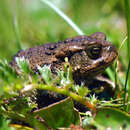Description
(
İngilizce
)
AmphibiaWeb articles tarafından sağlandı
This animal ranges in snout-vent length from 56-102 mm. It is very similar to the Common Toad (Bufo bufo), but differs from it mainly by having spines on the dorsal skin tubercles and a black band which extends from the outer surface of the parotoid onto the body flank. Tympanic membrane either very small or covered with skin. Dorsal skin tubercles large. Dorsal coloration dark-gray, olive-gray or olive-brownish, with three wide longitudinal bands. Wide dark band extends from the inner surface of the parotoid onto the body flank. This band is interrupted posteriorly into large spots. Belly grayish or yellowish, without pattern or with small spots posteriorly. The sexual differences are the same as in the Common Toad. Females are larger than males. The hindlegs seem to be relatively longer in males, whereas females have a wider head.
- Stejneger, L. H. (1907). Herpetology of Japan and Adjacent Territory, United States National Museum Bulletin 58. Smithsonian Institution, Washington, D. C..
- Won, H.-K. (1971). Choson Ryangso Pyachyungryuchji [Amphibian and Reptilian Fauna of Korea]. Korean Academy of Sciences, Pyongyang.
- Ye, C., Fei, L., and Hu, S. Q. (1993). Rare and Economic Amphibians of China. Sichuan Publishing House of Science and Technology, Chengdu.
- Zhao, E. and Adler, K. (1993). Herpetology of China. Society for the Study of Amphibians and Reptiles, Oxford, Ohio.
- Zhao, E. and Zhao, H. (1994). Chinese Herpetological Literature: Catalogue and Indices. Chengdu University of Science and Technology, Chengdu.
Distribution and Habitat
(
İngilizce
)
AmphibiaWeb articles tarafından sağlandı
Bufo gargarizans lives in China (provinces of Fujian, Hunan, Jiangxi, Zhajiang, Jiangsu, Anhui, Hubei, Guizhou, Sichuan, Qinghai, Gansu, Inner Mongolia, Shaanxi, Shanxi, Henan, Shandong, Hebei, Liaonin, Jilin and Heilongjiang), Korea, Japan, the Russian Far East (northwards to the Amur River valley, as well as some islands, including Sakhalin) and, evidently, East Siberia (Transbaikalia). The margins of distribution, as well as the systematic relationships of different populations currently designated as B. gargarizans, need further study.
Life History, Abundance, Activity, and Special Behaviors
(
İngilizce
)
AmphibiaWeb articles tarafından sağlandı
The population density of the toad reaches in some places 3600 individuals per square kilometer. Population density varies considerably between years and habitats. In the northeastern part of the range hibernation occurs from September - October to April - May, and reproduction from April - May, or in some habitats to late June. Hibernation occurs on land and also occurs in rivers and lakes at depths of more than one meter. Reproduction occurs in lakes, ponds, swamps, puddles, old riverbeds, ditches and rivulets with stagnant or semi-flowing water. Males enter breeding areas before females. Amplexus is pectoral. The clutch in the form of two strings of eggs, 1.5-2.3 m in length, containing 1200-7400 eggs. Metamorphosis occurs in summer. Mass mortality of B. gargarizans larvae occurs in pools with high tadpole density of the brown frog Rana dybowskii. Sexual maturity of this toad is probably attained during the 3rd-4th year of life; the majority of adults are 5-6 years old. Adult B. gargarizans consume insects, especially Coleoptera and Hymenoptera. Other invertebrates such as Mollusca, Myriapoda and Arachnoidea are eaten in smaller quantities.
Life History, Abundance, Activity, and Special Behaviors
(
İngilizce
)
AmphibiaWeb articles tarafından sağlandı
The Asiatic Toad is a widespread species and is not declining. Some peripheral populations, especially at the northern margin of the range (North China, probably Transbaikalia), are small and isolated, and they may be vulnerable to the alteration of habitats.
Relation to Humans
(
İngilizce
)
AmphibiaWeb articles tarafından sağlandı
The influence of anthropogenic factors on B. gargarizans is insufficiently known. The species possesses a good potential for synanthropization, especially in central, optimal parts of its range. It often occurs in settlements and cities which results, however, in its mortality on roads.

